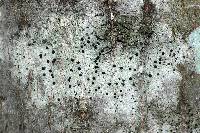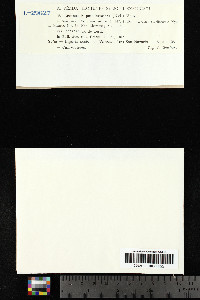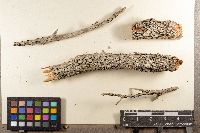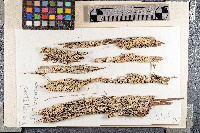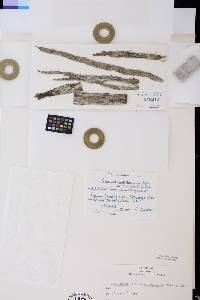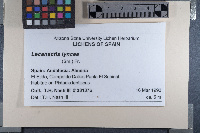
Consortium of Lichen Herbaria
- building a Global Consortium of Bryophytes and Lichens as keystones of cryptobiotic communities -
- Home
- Search
- Images
- Species Checklists
- US States: O-Z >
- US National Parks
- Central America
- South America
- US National Parks
- Southern Subpolar Region
|
|
|
|
Family: Arthoniales_family_incertae_sedis
[Bacidia clementis Hasse, moreLecanactis patellarioides (Nyl.) Vain., Lecidea patellarioides Nyl.] |
Nash, T.H., Ryan, B.D., Gries, C., Bungartz, F., (eds.) 2004. Lichen Flora of the Greater Sonoran Desert Region. Vol 2. Thallus: crustose, episubstratal, usually moderately thick, continuous, slightly cracked or areolate, forming scattered patches, sometimes poorly developed to inapparent surface: white, pale gray, or creamy white to yellowish gray, smooth to uneven or farinose to coarsely granulose, rugulose anatomy: up to 160 µm thick, ecorticate, with a thick epinecral layer up to 75 µm thick, without a differentiated medulla, I+ pale red or blue, K/I+ deep blue Ascomata: common, adnate to sessile, round to usually slightly irregular, constricted slightly at base, (0.2-)0.4-0.8(-1.2) mm wide disc: brownish black to black, plane to slightly convex, epruinose, smooth, or sometimes uneven and appearing pebbly margin: thin, black, conspicuous, smooth or more rarely crenulate, persistent or sometimes soon disappearing exciple: dark reddish brown to carbonaceous, open or rarely closed below the subhymenium, 50-80 µm wide above and 65-160(-250) µm wide at the base, I+ pale red or deep blue, K/I+ deep blue pseudoepithecium: hyaline to pale brown, granulose hymenium: hyaline to pale brown at periphery, (80-)110-200 µm tall, I+ pale red, K/I+ pale blue; paraphysoids: slightly branched but distinctly free, not coherent, not thickened, not colored at apices; apical cells: irregularly shaped, up to 4 µm wide, richly branched and densely interwoven but not reticulate, forming a dark reddish brown pseudoepithecium subhymenium: hyaline, less often yellowish gray to pale or medium brown, I+ pale red or deep blue, K/I+ deep blue asci: clavate to subcylindrical, (68-)90-135 x 11-13(-16) µm, apparently 8-spored; the wall at most slightly thickened at top when mature, I+ yellow ascospores: hyaline, transversely 12-17(-26)-septate, acicular or cylindrical with round ends without attenuation, difficult to dislodge from ascus, I-, usually straight but occasionally once or twice gently curled in ascus, Patellarioides-type, 57-85(-95) x (2.5-)3-4(-5) µm Pycnidia: common, partially immersed to adnate, protruding, punctiform, 170-250 µm tall and 170-200 µm wide; wall: apically brown, basally hyaline, 20-40 µm wide; sterigmata: straight, simple, black, 0.05 :m wide conidia: cylindrical, slightly curved, rarely straight, 8-13 x 0.8-1 µm Spot tests: thallus K+ pale brown, KC-, C-, P- Secondary metabolites: none detected. Notes: Bactrospora patellarioides var. convexa differs from the var. patellarioides in the following features: ascomata smaller (up to 0.6 mm in diam.), adnate, usually not constricted at base, with disc plane to convex and margins +excluded; exciple thinner, closed or rarely open below the subhymenium, 20-50 µm wide at the top and up to 80 µm wide at the base; subhymenium pale to dark brown; and conidia 13-17 x 0.8-1 µm. |
|
|
|
Powered by Symbiota



